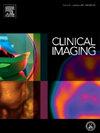Cardiovascular CT angiography in systemic and pulmonary venous anomalies of the thorax
IF 1.5
4区 医学
Q3 RADIOLOGY, NUCLEAR MEDICINE & MEDICAL IMAGING
引用次数: 0
Abstract
Thoracic venous anomalies are often asymptomatic and may go undetected by non-dedicated imaging studies. However, they have significant clinical relevance, as they can affect surgical planning, complicate interventional procedures, and predispose patients to pathological conditions such as arrhythmias, paradoxical embolism, and thrombosis. Understanding their embryologic development is critical for accurate diagnosis and differentiation from pathologic mimics. Major anomalies include left superior vena cava, retroaortic and retroesophageal left brachiocephalic veins, interruption of the inferior vena cava with azygos continuation, and various forms of anomalous pulmonary venous connections. Although many of these anomalies do not require surgical correction, their identification is essential to optimize procedural planning, particularly in patients with congenital heart disease where surgical modifications may be required. Failure to recognize these anomalies can lead to misdiagnosis, unnecessary interventions, and increased procedural risk. This review highlights the importance of identifying thoracic venous anomalies on imaging studies to ensure accurate diagnosis, prevent complications, and improve patient management.
胸腔全身及肺静脉异常的心血管CT血管造影
胸静脉异常通常是无症状的,非专用影像学检查可能无法发现。然而,它们具有重要的临床相关性,因为它们会影响手术计划,使介入程序复杂化,并使患者易患心律失常、矛盾栓塞和血栓形成等病理状况。了解它们的胚胎发育是准确诊断和区分病理模拟的关键。主要异常包括左上腔静脉、主动脉后静脉和食管后静脉左头臂静脉,下腔静脉中断伴奇静脉延续,各种形式的肺静脉连接异常。尽管许多此类异常不需要手术矫正,但它们的识别对于优化手术计划至关重要,特别是对于可能需要手术矫正的先天性心脏病患者。未能识别这些异常可能导致误诊,不必要的干预,并增加手术风险。这篇综述强调了在影像学研究中识别胸静脉异常的重要性,以确保准确诊断,预防并发症,并改善患者管理。
本文章由计算机程序翻译,如有差异,请以英文原文为准。
求助全文
约1分钟内获得全文
求助全文
来源期刊

Clinical Imaging
医学-核医学
CiteScore
4.60
自引率
0.00%
发文量
265
审稿时长
35 days
期刊介绍:
The mission of Clinical Imaging is to publish, in a timely manner, the very best radiology research from the United States and around the world with special attention to the impact of medical imaging on patient care. The journal''s publications cover all imaging modalities, radiology issues related to patients, policy and practice improvements, and clinically-oriented imaging physics and informatics. The journal is a valuable resource for practicing radiologists, radiologists-in-training and other clinicians with an interest in imaging. Papers are carefully peer-reviewed and selected by our experienced subject editors who are leading experts spanning the range of imaging sub-specialties, which include:
-Body Imaging-
Breast Imaging-
Cardiothoracic Imaging-
Imaging Physics and Informatics-
Molecular Imaging and Nuclear Medicine-
Musculoskeletal and Emergency Imaging-
Neuroradiology-
Practice, Policy & Education-
Pediatric Imaging-
Vascular and Interventional Radiology
 求助内容:
求助内容: 应助结果提醒方式:
应助结果提醒方式:


